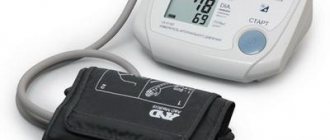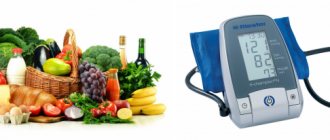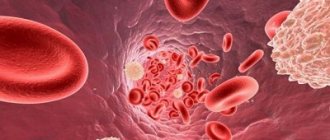Age-related changes in the human body are irreversible. We cannot turn back time, but we can control our own health and take measures to stabilize our well-being. One of the most important factors indicating health problems is blood pressure. They are influenced by: the general condition of the body, psycho-emotional factors, hormonal changes and, of course, the number of years lived. What is the normal blood pressure for a person by age, and what to do if the values on the tonometer are far from ideal?
How to measure blood pressure correctly?
Sometimes errors in pressure readings may be associated with improper use of a semi-automatic or automatic tonometer, most often used at home. It is important not only to check the functionality of the device, for example, the battery charge, but also to adhere to a number of simple rules, among which the following can be noted:
- You should not smoke before taking measurements. Of course, smoking, in principle, cannot be called a healthy habit, but if you smoke, try to give up cigarettes at least half an hour before the diagnostic procedure.
- Physical activity 30–60 minutes before measuring blood pressure (blood pressure) in an adult or child is also excluded. It is necessary to rest and relax, otherwise the indicators of the device will be inaccurate and can be misleading with sharply increased and decreased values.
- You should not eat shortly before measurement. Some foods can themselves raise blood pressure for a short time. A hearty dinner forces the body to work harder, which cannot but affect the results.
- Blood pressure should be measured in a sitting position, sitting on a chair with good back support. The hand should be at chest level (on the table). You cannot talk or gesture while the tonometer is working.
- For a more accurate measurement, it is necessary to measure blood pressure on one arm, and after 10 minutes - on the other. The lowest result will be accurate.
Advice! For both hypertension and hypotension, it will be useful to keep a journal in which data on blood pressure values and the time of measurements will be recorded.
Upper or systolic is the pressure at the moment when the heart muscle is at maximum tension, pushing blood into the arteries. Lower, or diastolic pressure at the time of diastole (rest). When making a diagnosis, not only the values themselves are taken into account, but also the difference between the upper and lower pressure, which normally does not exceed 20–40 mmHg. Art.
It is also important to take your heart rate into account. An increased or decreased pulse against a background of normal blood pressure may indicate a number of pathologies that require additional examination and treatment.
Rules for measuring blood pressure
{banner_banstat2}
To get a reliable picture of a person’s health status, it is important to measure blood pressure correctly; it’s not difficult:
- for an hour (at least 40 minutes) do not smoke, do not eat anything spicy, fatty, salty, do not drink strong drinks, coffee, tea;
- do not engage in physical labor;
- the position for measurement should be comfortable, in a sitting position, the hand for tonometry should be on a hard surface;
- two measurements are carried out, with an interval of several minutes;
- the cuff is placed above the elbow to make it comfortable when using a stethoscope.
Blood pressure standards for children and adolescents
In newborn children, the vessels are elastic and soft. That is why the blood pressure in children is always reduced. Blood simply does not have to make any effort to be transported throughout the body. With age, under the influence of internal and external factors, the picture changes. The vessels become stiffer, the pressure is higher.
Blood pressure table for children and adolescents
If in the first weeks of life the normal pressure is 80 to 40 mm Hg. Art. with a heart rate of 140 beats per minute, then by the age of one year the values increase to 100 per 60 mm Hg. Art., and the pulse rate decreases to 132. In adolescence, blood pressure levels are not much lower than in adults, however, hormonal changes during puberty can lead to an increase in systolic and diastolic pressure or a decrease in the range of 15–20 mm Hg. Art. from the norm. Such fluctuations are not traditionally treated by adjusting the daily routine and diet. Blood pressure returns to normal by the age of 16. The heart rate of a teenager from 12 to 16 years old is 75 beats per minute.
Normal for pregnant women
Up to 6 months, the pressure should be normal, that is, be the same as that of non-pregnant women.
Pregnant women have high blood pressure, but its significant increase is very dangerous for the health of the unborn child and mother. Hypertension can lead to vascular spasms and fetal hypoxia, placental abruption, bleeding
In the future, due to hormonal changes, it may increase, but not by more than 10 units. Pressure surges are usually observed with gestosis. If there is a persistent increase in blood pressure during pregnancy, treatment is required.
You can read about low blood pressure in pregnant women here.
What numbers are normal for an adult?
Adult standards also change over time. The ideal value is 120/80 mmHg. Art., in fact, is a reference only for young people leading a healthy lifestyle. And what is the norm for 30 years old is irrelevant for a person at 70–80 years old.
Normal blood pressure and pulse rates by age for women and men:
| Age | Women, mmHg Art. | Men, mmHg Art. |
| 20 years | 116/72 | 123/76 |
| from 21 to 30 years old | 120/75 | 126/79 |
| from 31 to 40 years old | 127/80 | 129/81 |
| from 41 to 50 years | 137/84 | 135/83 |
| from 51 to 60 years old | 144/85 | 142/85 |
| 70 years and older | 159/85 | 142/80 |
The average heart rate for adults is 60–80 beats per minute. However, this indicator, like blood pressure, is influenced by external and internal factors: diseases, stress, excess weight, bad habits, weather, etc. There are also age standards. For a forty-year-old person, the heart rate is 80 beats per minute, which is the norm, and for a 70-year-old, the normal pulse is 90. It is important to pay attention not only to the number, but also to the rhythm of the pulsating beats.
Norms by age
Previously, it was believed that normal blood pressure could increase with age. If for young people it should be 120/80, then for a person over 60 years old a value of 150/90 was allowed. Today, doctors say that there are no age-specific blood pressure standards for adults. Normal blood pressure is the same for everyone, with the exception of children.
High blood pressure is more common in older people
What are the reasons for fluctuations in blood pressure and heart rate?
The reasons for an increase or decrease in a person’s heart rate and blood pressure may be physiological. For example, associated with hypothermia, dehydration or living in high mountains, stress, and a sedentary lifestyle. Women especially often experience changes for physiological reasons. Fluctuations in blood pressure are considered normal not only during pregnancy or menopause, but also during menstruation. According to statistics, on the first day of menstruation, blood pressure decreases by 10 mmHg. Art. from the norm for age.
The blood pressure of a 9 year old child is normal
If deviations in blood pressure and pulse pressure differ significantly from the norm, you should contact a specialist (pediatrician, therapist or cardiologist), who will prescribe an additional examination that can explain why this problem arose. The reasons may be the following:
- disruption of the heart, which does not allow the organ to work with the necessary force;
- changes in blood composition caused by endocrine and autoimmune pathologies;
- atherosclerosis, in which cholesterol plaques form on the walls of blood vessels;
- a decrease in the elasticity of blood vessels or a decrease in the lumens in them, associated with age, hormonal processes in the body, taking medications, intense physical activity, and nutritional disorders.
The risk of hypertension increases in overweight people
What is optimal blood pressure?
Many patients are concerned about the question of what optimal pressure is and how to determine it correctly.
A person experiences surges in blood pressure throughout the day; it is not constant. There is a decrease at night, during periods of deep sleep, and an increase when waking up and doing household chores. And that's absolutely normal. It is caused primarily by physiological processes occurring in the body. The meaning may change after eating, taking a bath or shower, during stressful, negative situations.
Functional system that maintains optimal blood pressure levels
Optimal blood pressure is the one at which a person feels good. It may not meet established standards, be higher or lower than recommended limits. Thus, the concept of an optimal level means a possible range of changes, the average value of indicators during the day.
Memo for measuring blood pressure
The best way to determine your optimal blood pressure level is to measure it throughout the day. It is necessary on both hands several times a day .
This should be done half an hour after a meal, bath or shower, or physical activity. You need to take a comfortable, relaxed position and follow the measurement instructions for a specific tonometer.
Based on the obtained values, determine the average values of the lower and upper limits. To do this, you need to add the resulting values and divide by the number of measurements.
Eg:
- The numbers received were 120/80, 110/90, 115/75.
- The upper limit is 120+110+115 and divided by three. That turns out to be 115.
- The lower limit is 80+90+75 and divided by three. That turns out to be 82.
- This means that the optimal arterial indicator is 115/82.
These calculations are approximate , but they allow you to keep your health and well-being under control.
Recommended viewing:
Characteristic symptoms of hypertension and hypotension
At the first stage of hypertension, pressure surges up to 159/99 mm Hg occur. Art. Most often, malaise occurs after severe overwork or stress. Patients note an increase in heart rate and headaches, weakness, and increased nervous excitability.
At the second stage, the following symptoms include: deterioration of sleep, nosebleeds, pain in the heart, severe headaches. Blood pressure rises to 160–170/100–109 mmHg. Art.
The third stage of hypertension is a serious disease that irreversibly affects the entire human body. This stage is characterized by cardiac dysfunction, chronic renal and heart failure, heart attack, and angina.
Important! If at the first stage the patient’s condition can be corrected and the disease goes away almost without a trace, but stages 2 and 3 of hypertension are practically not curable. The goal of the doctor and his patient is to monitor the condition and regularly take antihypertensive drugs that can stabilize the patient’s well-being for some time.
Low blood pressure manifests itself differently. A person suffers from headaches, which are localized in the temporal region, loss of strength, drowsiness, dizziness, nausea, and fainting. Symptoms worsen during weather changes, magnetic storms, and during acclimatization.
Both hypertension and hypotension require treatment. What it will be like and how long it will last depends on the patient’s health condition. It is necessary to strictly adhere to the treatment regimen drawn up by the doctor, without independently increasing or decreasing the dosage of drugs.
Prevention measures
Age factors cannot be eliminated. However, a person of any age can delay the onset of cardiovascular diseases. To do this, you should adhere to certain rules, which should not be temporary, but permanent, even for a completely healthy person.
- Smoking and alcohol abuse are the main enemies of the heart and blood vessels. By getting rid of bad habits, you can protect yourself for a long time from problems with changes in blood pressure and their consequences.
- No matter how busy your work schedule is, make time for physical activity. If it is not possible to go to the gym, walking in the fresh air and morning exercises can be an alternative.
- In both adults and children, problems with blood pressure can be associated with stress and overwork, which occur in people of any gender and occupation. It is important not only to study and work fruitfully, but also to fully relax. Night rest is especially valuable, so you should refrain from working at night.
- Pay attention to weight. Every extra kilogram increases the load on the heart and blood vessels, which cannot but affect blood pressure. A balanced diet and regular physical activity will not only improve your figure, but also protect against changes in blood pressure.
- The condition of the heart and blood vessels largely depends on what food predominates in your diet. Eating disorders can lead to the formation of cholesterol plaques - the first step to hypertension. The menu should consist of lean meat, sea fish, cereals, whole grain bread, fruits, vegetables, and vegetable oils.
Important! Treatment of diseases - chronic and acute - must be timely. Regular visits to doctors will allow you to prolong your youth and avoid many problems with both blood pressure and the functioning of internal organs and systems.
Features of the treatment of high blood pressure in the elderly
The reasons why blood pressure increases in older people vary, so treatment of hypertension should be carried out in such a way as to avoid possible complications. That is why the doctor must be able to react in time and, if necessary, change the method of administration of the drug.
If treatment is not organized correctly, the risk of vasoconstriction increases, resulting in a possible heart attack and stroke.
Attention also needs to be paid to the kidneys, since fluid from the body must leave the body in the required quantity, otherwise its accumulation can lead to increased pressure. Therefore, together with drugs aimed at lowering blood pressure, the doctor prescribes a diuretic. Although it is worth noting that modern medications for normalizing blood pressure levels already contain nephrological agents.











